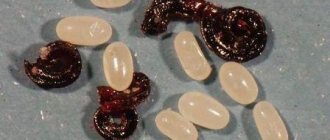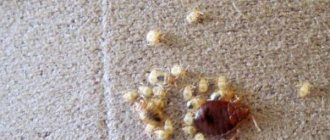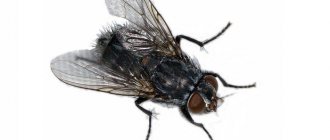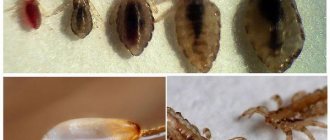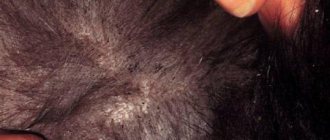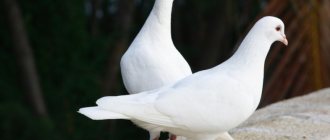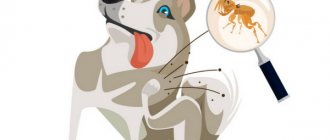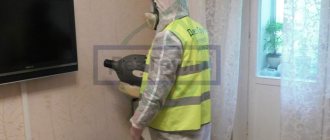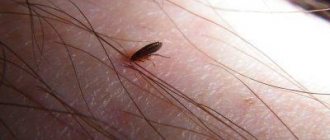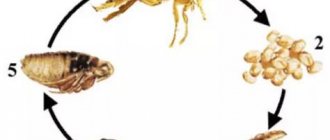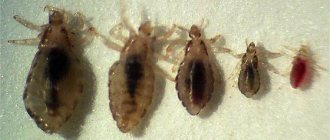Fleas belong to the order of blood-sucking insects. They can be called carriers of pathogens of various diseases that pose a danger to humans and animals.
Wingless insects have a highly specialized oral apparatus necessary for puncturing the skin of the victim and further sucking blood.
Being small in size, parasites are capable of jumping long distances. They often enter houses through basements, entrances, small cracks, and microcracks . Sometimes they can be found even in apartments where there are no pets. If the owner promptly discovered that his pet was suffering from parasites and removed them using special means, flea eggs may still remain in the house, which, under favorable conditions, subsequently become adults capable of leaving offspring.
What do flea larvae look like?
Often, many people, faced with the problem of removing fleas, are interested in what a flea egg looks like? In fact, since both humans and animals can be carriers of parasites, there are some differences that are very difficult to determine without special knowledge.
If we consider the color of a cat or dog flea egg, its shape and size, we can highlight the following features:
- oval shape;
- miniature size (up to 1 mm);
- White color.
The larvae of bloodsuckers that infect animals resemble tiny translucent worms that, after hatching from the egg, remain there until full maturity.
Anabiosis is possible because they do not require blood as food in this state.
Under a microscope, you can see that the entire body of the larva is covered with small hairs; there are no legs. Since the body is translucent and whitish in color, the esophagus with food digesting in it is clearly visible. The larva has a large head for its size with powerful jaws. This feature allows the larva to feed on the toughest food that it comes across.
Do fleas fly or not, do they have wings?
Many people who have seen how quickly and far fleas move in space have a logical question: can these insects fly.
The structural features of the insect are such that it does not have wings. But the long hind legs and the dense shield on the front of the body made of protein matter deserve special attention.
The locomotor system of the parasite is designed like a tiny catapult: when the legs are bent, the shield is pulled back, and when unbent, the flea seems to shoot into the air. The remaining two pairs of legs help the parasite when jumping and landing. In a calm state, the insect collects its limbs in the shape of an accordion so as not to interfere with feeding.
Even the very shape of the bloodsucker’s body – flattened on the sides – gives the parasite ergonomics and additional advantages when moving.
The body length of the blood-sucking insect is no more than 2–3 mm, but the flea jumps over distances up to 100 times greater. In one jump, the pest covers 20 cm in length and up to 35 cm in height.
Thus, fleas do not fly, but they jump high and far, which is why it often seems to a person that the insect moves exclusively in flight.
How do they reproduce?
Despite the fact that fleas reproduce quickly, the process itself is quite complex and requires maintaining certain favorable conditions. The male has testes (2 pieces), ending with genital claws, through which the seed is transmitted to the female. The female has 2 or 4 ovaries, oviducts connecting at the body of the uterus, containing the spermatheca, located at the end of the abdomen in the form of a curved tube.
At the moment of mating, the female climbs onto the male’s back, after which she sucks up the sexually mature organ with the spermatheca. From the testes of a male to the body of a female flea, the seed travels on average about 10–15 minutes. While mating itself can last about a day.
After fertilization, the flea lays eggs in batches (4 to 10 pieces). Since the female needs strength for this, she must be satisfied with food before laying eggs. With normal saturation, a blood-sucking female is capable of laying eggs several times a day.
However, more often females lay one portion per day. Over the entire life cycle of a flea, it is capable of laying 500 eggs, which often infect a pet.
Due to the fact that insects place future offspring on the carrier in advance, subsequently the larvae can easily get enough food and grow quickly. In addition to animal fur, fleas leave clutches in places where they frequent.
The laying process is unique - the female throws eggs from her abdomen over a long distance. It is this method that ensures the vitality of the offspring, since they are at a distance and can eat normally without creating competition for each other.
Facts from biology
Fleas are wingless insects whose flat body is laterally compressed. The long legs are strewn with spines and hairs, and antennae are hidden inside the recesses on the sides of the head. The oral apparatus, adapted for piercing the skin and sucking blood, consists of a proboscis, a pair of palps and a pair of short mascilla. The body length of fleas is usually 2-4 mm, in rare species it reaches 6-8 mm. Flea larvae are worm-shaped, without legs, with a rounded head, each body segment is covered with hairs.
Fleas feed on the blood of mammals and birds and live on the body of the host or in nests, burrows and animal trails. Flea eggs are transparent white, oval in shape. Females drop eggs in the owner's fur or in his nest.
In nature, non-adhesive flea eggs laid on the host's body roll down the hairline and fall into the litter of a nest or shelter, where larvae soon appear. In an apartment, eggs accumulate in floor cracks, in carpets, and in places where house dust and dirt accumulate.
Flea larvae develop in the soil and in the substrate of nesting bedding, and in an apartment - in pets' bedding, in carpets, in upholstery and in dust on the floor. They feed on the anal secretions of adults and lead an active life. Typically, 50-60% of each flea colony consists of larvae.
Having reached its final size, the larva weaves an irregularly shaped cocoon in the host's nest or carpet and pupates there. For the imago to emerge, mechanical stimulation is required, such as vibration from feet on the floor. Therefore, the appearance of a person in an empty room provokes a sudden emergence of a mass of adult fleas from the pupae.
Without signals of the presence of a host, the flea pupal stage lasts up to 5 months. Under favorable conditions, the flea development cycle lasts 2-4 weeks. Flea eggs, larvae and pupae are not visible without a thorough examination.
Video: Reproduction of fleas - larvae in the carpet
Adults are extremely mobile, moving deftly in fur and feathers; moreover, the body of fleas is equipped with ridges, bristles and spines that help such movement. Some species live permanently on the host's body, while others live in the nest and attack the host only for food.
Dog and cat fleas (Latin names Ctenocephalides canis and C.felis), as well as the human flea (Pulex irritans), attack people and breed in living spaces, creating discomfort and even making them uninhabitable.
Where to look for them
Maturing individuals can be found not only in the fur of animals, but also in various places in the room or apartment where they live. They can be found in corners, crevices, microcracks in floors, behind baseboards, under wallpaper.
Formed bloodsuckers can settle in warm blankets, under the upholstery of upholstered furniture, and inside pillows. Since these insects are blood-sucking, feeding exclusively on blood, their habitat is limited to areas where a person or animal is often found. Thanks to this, they can always find food to survive.
The most likely habitats in which fleas live without an animal in an apartment are:
- sleeping places for pets;
- cracks behind the baseboards, in the floor;
- carpets, upholstered furniture, pile of toys;
- places with high humidity levels (under the bathtub, sink, shower).
Since the female parasite shoots her eggs in different directions when laying eggs, they can colonize any surface. And since the bedding of cats and dogs contains everything necessary for the full development of flea larvae, in addition to the animal’s fur, the flea larva feels comfortable in a sleeping place.
Adults
The parasites that most insecticides target are adult fleas. An adult insect can reach up to 5 millimeters in size, has a black (these are young fleas) or brown color, and is covered with scales. In the animal's fur, the pest is somewhat reminiscent of a small grain of a plant.
The main difference between fleas and other insects: pests can jump up to thirty centimeters in length, escaping from danger or moving from victim to victim. Sometimes these jumps can be seen with the naked eye. Fleas differ from bed lice in their large size, and from bedbugs in their ability to jump.
Lifestyle and nutrition of future parasites
Flea larvae are not parasites, since they feed on decaying organic compounds, which make up particles of dead plants, excrement of formed fleas, containing undigested crusts of the victim's blood.
The larvae themselves do not feed on blood, therefore in this state they are harmless to humans and animals.
Maturation of the larvae lasts from 2 to 14 days. After this, the eggs hatch and small parasites continue to develop. The period of final maturation depends on environmental conditions; the more comfortable the larva feels, the faster the process of formation of the individual occurs.
If the ambient temperature is warm enough and there is a high level of humidity, the larvae will develop into an adult within a couple of days. An underdeveloped individual feeds on the feces of mature individuals, dried blood crust, and other layers of organic matter.
As the larva grows, it molts (3 times), after which it pupates like a butterfly. The time the larva remains in the cocoon ranges from several weeks to several months. It depends on the environmental conditions.
If they are unfavorable, the cocoon can remain unchanged for a year until the victim is in close proximity. According to scientists, even in the pupal state, a flea can smell blood. After emerging from the cocoon, the final stage of insect development begins.
Appearance of the larvae
Flea larvae
What flea larvae look like depends on the stage of development. Initially they are born as white, translucent worms. Length does not exceed 1 mm. Their food consists of feces of adults, skin remains, and rot. They begin to eat actively.
Over time, worms accumulate in places where they can find food:
- dog bedding, cat mats;
- trash bins;
- baskets for storing vegetables, flower pots;
- pet toilet, feeders.
A week later, the first molt occurs. Flea larvae increase in size, but do not change appearance. The worms are already more like a caterpillar. The contents of the esophagus are visible through the transparent body. The color becomes dirty gray. During the entire developmental stage, the flea molts three times. Increases to 4 mm.
At the last stage of flea development, pupation occurs. The larva envelops itself in a cocoon and stops moving. Already after 2 days it emerges from there as an adult.
On a note!
Flea larvae do not live on cats' bodies. You should look for them near the sleeping place, near the toilet. Check all the places where your pet likes to relax and spends a lot of time. Dogs also develop fleas. Animals are not even the host for these parasites. Development occurs outside the body.
Are they dangerous for humans?
Fleas and their larvae can be carriers of various serious diseases that pose a threat to human life:
- Bubonic plague;
- encephalitis;
- anthrax;
- trypanosomiasis;
- tularemia;
- typhus and relapsing fever, etc.
The likelihood of a threat may not be the norm, but a certain percentage remains. This is the most terrible threat to human health and life.
In addition, if you eat food without washing the eggs with your bare hands, you can become infected with various types of worms.
Danger to humans and animals
We all know how dangerous these parasites are for animals. The first thing that causes inconvenience to animals is the pain that comes from a flea bite. These insects do not produce enzymes that relieve pain when the skin is pierced. Therefore, a bite resembles a needle prick; when there are a lot of insects on the body, the animal feels quite severe pain.
But unfortunately, the torment does not end there. After a bite, the animal suffers from severe itching, which is simply impossible to tolerate, which leads to severe scratching and wounds. The skin becomes irritated and inflamed, and open wounds become an ideal place for infection to penetrate. If no action is taken, serious consequences arise.
Since these insects parasitize animals, many believe that they pose no danger to humans. This is a misconception, since fleas are among those insects that carry dangerous and even fatal diseases. These include encephalitis, plague, typhus, tularemia and others. Of course, not every flea is infected and carries diseases, but the possibility exists, which is very dangerous to health.
How to get rid of pests
Many, faced with this problem, wonder how to get rid of flea larvae? The first need when detecting insects on your beloved pet is to thoroughly clean the apartment.
The use of insecticidal drops and a flea collar for animals is not enough, since the laid eggs of parasites can remain in a state of suspended animation for a long time, and are activated when favorable conditions for life occur.
Treatment of premises against fleas and their eggs consists of several stages:
- carrying out general cleaning to get rid of eggs and parasite larvae as much as possible;
- spraying chemicals on furniture moved to the center and overturned, carpets infested with flea larvae. The most popular include Executioner, Cucarachi, Tetrix, Raptor, Combat;
- sealing the room for several hours (pets should also not be in the apartment during this entire time).
After the treatment has been carried out, it is necessary to ventilate the room well, beat the carpets outside, then vacuum them. In the warm season, some resort to airing and drying furniture, exposing it outside to the scorching rays of the sun.
This is explained by the fact that fleas and their larvae die at high temperatures. Therefore, in addition to chemical reagents, it is necessary to treat premises with high temperatures.
Methods for killing parasites
Although the larvae do not pose a danger to people and animals, they are exterminated, as they later turn into aggressive insects.
Not all drugs that are used to kill adult insects can rid an apartment of their offspring. Aerosols quickly cease to be effective after application and are therefore of little use for combating larvae.
To exterminate them, they use species equipped with attachments to penetrate hard-to-reach places. Strong-smelling plants such as wormwood repel adult fleas but have no effect on larvae.
Insecticidal flea dusts work flawlessly. They mix with the food that the parasites eat and enter the body, causing them to die. But with their help it is difficult to exterminate the larvae that have bred under the floor. Microencapsulated preparations Get, concentrated preparations Tetrix, Karbofos, Cucaracha are also suitable for killing parasites.
Prevention
To destroy the pest, it is necessary to use special drops (with fipronil, selamectin, metaflumizone), which are dripped between the shoulder blades, sprays, oral medications (tablets, suspensions, etc.), shampoos or collars.
It is best to first treat the affected Murka with an external remedy, and then secure the result with a collar or oral medication.
Important! Collars containing products such as permethrin (deadly), amitraz, or organophosphates should not be used on cats. Next, you need to comb out all the insects and their eggs from the wool using a comb with thicker teeth.
Don't forget to treat your apartment with insecticides: especially old furniture, closets and cracks on the floor. But it is better to call a special service for these purposes. This way you will neutralize their breeding sites, and also destroy pupae and larvae
Next, you need to comb out all the insects and their eggs from the wool using a comb with thicker teeth. Don't forget to treat your apartment with insecticides: especially old furniture, closets and cracks on the floor. But it is better to call a special service for these purposes. This way you will neutralize their breeding sites, and also destroy pupae and larvae.
Next, you can support your pet with vitamins or medications with sulfur (if anemia appears) and treat the affected skin with ointments.
Fleas are not only unpleasant itching and bites, but also a threat to your pet’s health. Therefore, try to examine his coat as often as possible and apply parasite control measures immediately.
Prevention of fleas in animals
No less important than treatment for parasites is their prevention. Knowing where fleas come from, how they reproduce and what kind of lifestyle they lead, you can try to protect your animal from such “neighbors”.
And there are many options for picking up these insects: from contact with other infected animals to walks in the park and trips out of town. After all, dog fleas live on trees, on grass, and just on the ground. Even a person can bring them home on himself. And small puppies can become infected from their own mother, who has these parasites.
Therefore, it is especially important to ensure that all the pet’s habitats are kept clean: clean all surfaces with a vacuum cleaner, use an aerosol to kill fleas, bathe the pet with a special anti-flea shampoo, and also comb the fur with a comb. And if such preventive measures are taken carelessly, diseases caused by fleas can be fatal for the animal.
Insect habitats
Fleas do not live on the animal itself. Insects prefer to settle next to a potential breadwinner: in caves, nests and burrows of animals and birds. This is necessary in order to have free access to food and drink blood at any time.
It is much easier for insects to survive in an apartment or residential building. Their habitats may be:
- bedding and resting places for pets (houses, mattresses, baskets),
- floor cracks, baseboards and carpets,
- bed sheets,
- deposits of clothes,
- furniture, bed mattresses,
- storage areas for vegetables or garbage.
The eggs fall to the floor directly from the animal, so they can end up anywhere, but the most common habitats are those that are closer to the owner - the bed and carpets.
Lifespan of fleas
The average lifespan of a parasite is 3–4 months. But everything depends on external conditions:
- air humidity,
- air temperature,
- availability of food.
If fleas are infested in an apartment where there is no control over them or pets, the lifespan is not reduced. In the absence of animals, fleas do not disdain human blood, even if they are representatives of the dog and cat families. In addition, parasitism on dogs and cats, on the contrary, is more dangerous for them - animals have instinctive cleanliness and kill parasites by gnawing with their fangs and combing.
Fleas can live without food for 4–5 months. They do not slow down their development, but they stop producing offspring. However, cat fleas are known for discarding insects that starve to death within 12 hours (males) and 96 hours (females).
The survival rate of insects also depends on a number of accidents:
- according to statistics, less than half of the eggs laid by one insect survive the full cycle of transformation,
- some eggs and adult insects can be eaten by the breadwinner,
- Eggs are laid at any time of the day and at any moment. Therefore, they can find themselves either indoors and warm, or on a cold frosty street where it is impossible to survive. If the eggs end up in a place where the future larva has nothing to feed on and a lot of sunlight, then the insect also has no chance of surviving.
Reproduction of fleas at home
Insects have a well-developed reproductive function. A flea colony multiplies rapidly in comfortable living conditions. One female lays 350–450 eggs during her life.
Flea reproduction (photo)
Fleas literally squeeze eggs out of themselves, scattering them throughout their habitat. Therefore, you can find small larvae that look like tiny grains of rice in any corner of the apartment. After hatching, the flea looks like a worm with bristles. After two weeks it turns into an adult, moults 3 times, and feeds on the dried droppings of adults.
Note! A flea infestation can be determined by painful bites on the skin. The affected area develops noticeable and painful redness, accompanied by severe itching. There is compaction in the center. One individual bites a person 3–5 times in a couple of seconds.
